NMIH308 Assessment 2: Clinical Negligence, Patient Care, and Handover
VerifiedAdded on 2022/11/18
|10
|2837
|345
Report
AI Summary
This report examines a case of clinical negligence in nursing, specifically focusing on the death of a patient with pyelonephritis due to inadequate care and a flawed handover process. The assignment applies the clinical reasoning cycle to analyze the situation and identifies key issues, including insufficient staffing, lack of regular patient assessment, and poor handover practices. The report then delves into three key articles. The first article explores the challenges faced by nurses in critical care settings, highlighting the impact of resource allocation on patient care. The second article discusses the management of acute pyelonephritis, emphasizing the importance of tailored treatment based on patient profiles. The third article examines the benefits of standardized shift handover protocols in improving communication and patient safety. The report concludes by emphasizing the importance of adhering to clinical guidelines, ensuring adequate staffing, and implementing effective handover protocols to prevent clinical errors and improve patient outcomes. This assignment underscores the significance of evidence-based practice and its role in enhancing the quality of nursing care.

Running head: ASSESSMENT 2
1
Assessment 2
Student’s Name
University
1
Assessment 2
Student’s Name
University
Paraphrase This Document
Need a fresh take? Get an instant paraphrase of this document with our AI Paraphraser
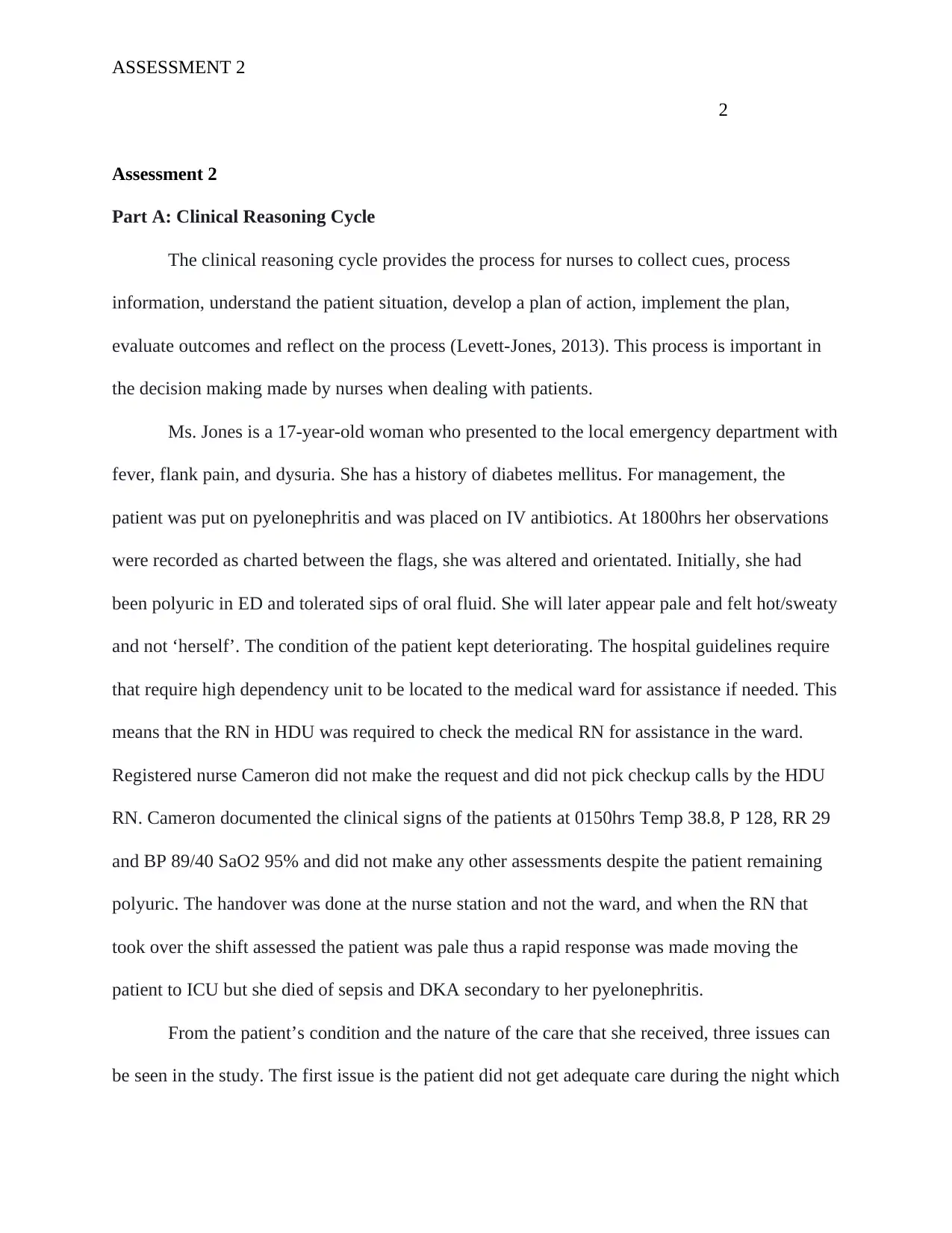
ASSESSMENT 2
2
Assessment 2
Part A: Clinical Reasoning Cycle
The clinical reasoning cycle provides the process for nurses to collect cues, process
information, understand the patient situation, develop a plan of action, implement the plan,
evaluate outcomes and reflect on the process (Levett-Jones, 2013). This process is important in
the decision making made by nurses when dealing with patients.
Ms. Jones is a 17-year-old woman who presented to the local emergency department with
fever, flank pain, and dysuria. She has a history of diabetes mellitus. For management, the
patient was put on pyelonephritis and was placed on IV antibiotics. At 1800hrs her observations
were recorded as charted between the flags, she was altered and orientated. Initially, she had
been polyuric in ED and tolerated sips of oral fluid. She will later appear pale and felt hot/sweaty
and not ‘herself’. The condition of the patient kept deteriorating. The hospital guidelines require
that require high dependency unit to be located to the medical ward for assistance if needed. This
means that the RN in HDU was required to check the medical RN for assistance in the ward.
Registered nurse Cameron did not make the request and did not pick checkup calls by the HDU
RN. Cameron documented the clinical signs of the patients at 0150hrs Temp 38.8, P 128, RR 29
and BP 89/40 SaO2 95% and did not make any other assessments despite the patient remaining
polyuric. The handover was done at the nurse station and not the ward, and when the RN that
took over the shift assessed the patient was pale thus a rapid response was made moving the
patient to ICU but she died of sepsis and DKA secondary to her pyelonephritis.
From the patient’s condition and the nature of the care that she received, three issues can
be seen in the study. The first issue is the patient did not get adequate care during the night which
2
Assessment 2
Part A: Clinical Reasoning Cycle
The clinical reasoning cycle provides the process for nurses to collect cues, process
information, understand the patient situation, develop a plan of action, implement the plan,
evaluate outcomes and reflect on the process (Levett-Jones, 2013). This process is important in
the decision making made by nurses when dealing with patients.
Ms. Jones is a 17-year-old woman who presented to the local emergency department with
fever, flank pain, and dysuria. She has a history of diabetes mellitus. For management, the
patient was put on pyelonephritis and was placed on IV antibiotics. At 1800hrs her observations
were recorded as charted between the flags, she was altered and orientated. Initially, she had
been polyuric in ED and tolerated sips of oral fluid. She will later appear pale and felt hot/sweaty
and not ‘herself’. The condition of the patient kept deteriorating. The hospital guidelines require
that require high dependency unit to be located to the medical ward for assistance if needed. This
means that the RN in HDU was required to check the medical RN for assistance in the ward.
Registered nurse Cameron did not make the request and did not pick checkup calls by the HDU
RN. Cameron documented the clinical signs of the patients at 0150hrs Temp 38.8, P 128, RR 29
and BP 89/40 SaO2 95% and did not make any other assessments despite the patient remaining
polyuric. The handover was done at the nurse station and not the ward, and when the RN that
took over the shift assessed the patient was pale thus a rapid response was made moving the
patient to ICU but she died of sepsis and DKA secondary to her pyelonephritis.
From the patient’s condition and the nature of the care that she received, three issues can
be seen in the study. The first issue is the patient did not get adequate care during the night which
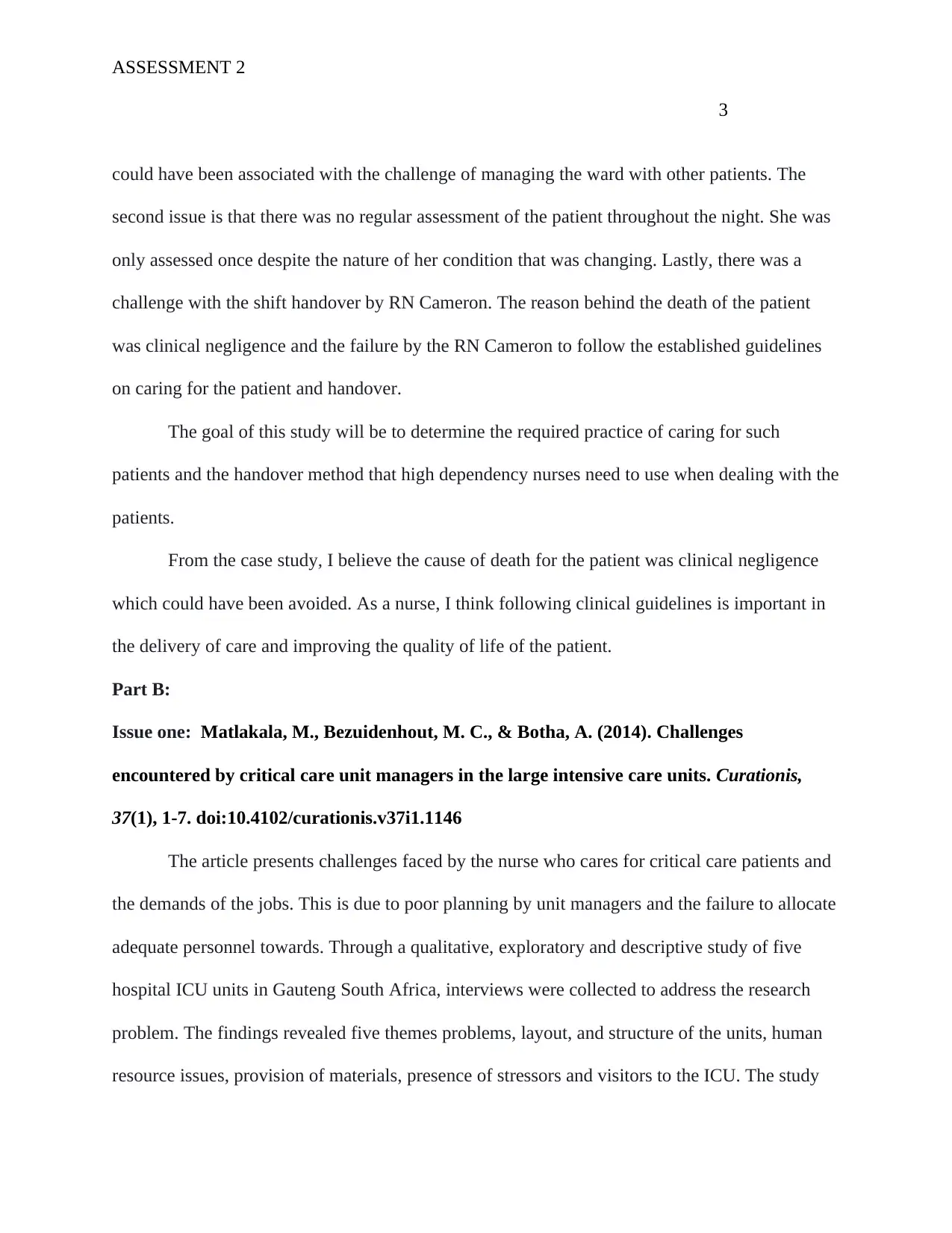
ASSESSMENT 2
3
could have been associated with the challenge of managing the ward with other patients. The
second issue is that there was no regular assessment of the patient throughout the night. She was
only assessed once despite the nature of her condition that was changing. Lastly, there was a
challenge with the shift handover by RN Cameron. The reason behind the death of the patient
was clinical negligence and the failure by the RN Cameron to follow the established guidelines
on caring for the patient and handover.
The goal of this study will be to determine the required practice of caring for such
patients and the handover method that high dependency nurses need to use when dealing with the
patients.
From the case study, I believe the cause of death for the patient was clinical negligence
which could have been avoided. As a nurse, I think following clinical guidelines is important in
the delivery of care and improving the quality of life of the patient.
Part B:
Issue one: Matlakala, M., Bezuidenhout, M. C., & Botha, A. (2014). Challenges
encountered by critical care unit managers in the large intensive care units. Curationis,
37(1), 1-7. doi:10.4102/curationis.v37i1.1146
The article presents challenges faced by the nurse who cares for critical care patients and
the demands of the jobs. This is due to poor planning by unit managers and the failure to allocate
adequate personnel towards. Through a qualitative, exploratory and descriptive study of five
hospital ICU units in Gauteng South Africa, interviews were collected to address the research
problem. The findings revealed five themes problems, layout, and structure of the units, human
resource issues, provision of materials, presence of stressors and visitors to the ICU. The study
3
could have been associated with the challenge of managing the ward with other patients. The
second issue is that there was no regular assessment of the patient throughout the night. She was
only assessed once despite the nature of her condition that was changing. Lastly, there was a
challenge with the shift handover by RN Cameron. The reason behind the death of the patient
was clinical negligence and the failure by the RN Cameron to follow the established guidelines
on caring for the patient and handover.
The goal of this study will be to determine the required practice of caring for such
patients and the handover method that high dependency nurses need to use when dealing with the
patients.
From the case study, I believe the cause of death for the patient was clinical negligence
which could have been avoided. As a nurse, I think following clinical guidelines is important in
the delivery of care and improving the quality of life of the patient.
Part B:
Issue one: Matlakala, M., Bezuidenhout, M. C., & Botha, A. (2014). Challenges
encountered by critical care unit managers in the large intensive care units. Curationis,
37(1), 1-7. doi:10.4102/curationis.v37i1.1146
The article presents challenges faced by the nurse who cares for critical care patients and
the demands of the jobs. This is due to poor planning by unit managers and the failure to allocate
adequate personnel towards. Through a qualitative, exploratory and descriptive study of five
hospital ICU units in Gauteng South Africa, interviews were collected to address the research
problem. The findings revealed five themes problems, layout, and structure of the units, human
resource issues, provision of materials, presence of stressors and visitors to the ICU. The study
⊘ This is a preview!⊘
Do you want full access?
Subscribe today to unlock all pages.

Trusted by 1+ million students worldwide

ASSESSMENT 2
4
concluded that there are multifaceted challenges faced by both nurses and unit managers which
limit the efficiency of nurses to care for the patients. This study proposes the use of multiple
strategies for efficient management of the units.
Matlakala, Bezuidenhout, & Botha (2014) present the huge demands that nurses caring
for critical patients face inwards. EDs, HDUs, and ICUs are specialized hospital wards for
providing patient care for patients suffering from life-threatening conditions that make require
them to be treated as special patients. The nature of the healthcare facility that exists, its size and
the number of patients determines the challenge that such patients face. According to the
American Association of Critical-Care Nurses (2017) nurses who work in these units are
exposed to huge patient demands in terms of the need to fulfill the roles placed on them. As seen
in the case study, RN Cameron was on the night shift alone with a newly graduated RN in a 16-
bed medical ward. Apart from Ms. Jones, two male other admitted male patients were distressed
and also required regular monitoring, assessment of support. This means that the RN Cameron
was overwhelmed with the workload and this may have led to the failure to meet all patient
needs for Ms. Jones.
The evidence in the article is supported by Thompson, Hamilton, Cadenhead, Swoboda,
& Schwindel (2012) who argued that there is a need for proper resource allocation within clinical
care facilities to improve nursing efficiency. Matlakala, Bezuidenhout, & Botha (2014)
concluded that to improve practice and quality of care with critical care settings, it is important
to ensure that there is adequate staffing in specific wards where patients present the need for
regular monitoring and assessment. This will reduce burnout and overwhelm of work which
compromises the quality of life of the patient.
4
concluded that there are multifaceted challenges faced by both nurses and unit managers which
limit the efficiency of nurses to care for the patients. This study proposes the use of multiple
strategies for efficient management of the units.
Matlakala, Bezuidenhout, & Botha (2014) present the huge demands that nurses caring
for critical patients face inwards. EDs, HDUs, and ICUs are specialized hospital wards for
providing patient care for patients suffering from life-threatening conditions that make require
them to be treated as special patients. The nature of the healthcare facility that exists, its size and
the number of patients determines the challenge that such patients face. According to the
American Association of Critical-Care Nurses (2017) nurses who work in these units are
exposed to huge patient demands in terms of the need to fulfill the roles placed on them. As seen
in the case study, RN Cameron was on the night shift alone with a newly graduated RN in a 16-
bed medical ward. Apart from Ms. Jones, two male other admitted male patients were distressed
and also required regular monitoring, assessment of support. This means that the RN Cameron
was overwhelmed with the workload and this may have led to the failure to meet all patient
needs for Ms. Jones.
The evidence in the article is supported by Thompson, Hamilton, Cadenhead, Swoboda,
& Schwindel (2012) who argued that there is a need for proper resource allocation within clinical
care facilities to improve nursing efficiency. Matlakala, Bezuidenhout, & Botha (2014)
concluded that to improve practice and quality of care with critical care settings, it is important
to ensure that there is adequate staffing in specific wards where patients present the need for
regular monitoring and assessment. This will reduce burnout and overwhelm of work which
compromises the quality of life of the patient.
Paraphrase This Document
Need a fresh take? Get an instant paraphrase of this document with our AI Paraphraser

ASSESSMENT 2
5
This article is important to nursing practice since it highlights the challenges faced by
nurses which hinder efficiency and delivery of care. Specifically, there is the issue of resource
allocation which has to be considered by unit managers in ensuring that the quality of life of the
patient is not compromised. As seen in the case of Ms. Jones, the nature of the ward that RN
Cameron was working in created difficulties in meeting all her clinical needs. Thus it is
important for the distribution of resources according to the patient issues that exist in the
hospital. This means that the clinical outcome of the patient could have been better if the patient
was only managing one patient as compared to all of them.
Issue two: Johnson, J. R., & Russo, T. A. (2018). Acute Pyelonephritis in Adults. The New
England Journal of Medicine, 378(1), 48-59. doi:10.1097/CCM.0b013e31825b94d8
Johnson & Russo (2018) study presented an overview of different ways of managing
acute pyelonephritis in different patients. The authors present that there is a lack of consensus on
the diagnostic criteria since some studies show that patients did not have bladder problems,
others lacked flank pain or tenderness. This shows that clinical manifestation and severity of the
disease vary from patient to patient. The study presented the use of different tests to assess the
condition like urine culture, blood culture, initial imaging to identify obstruction, abscess or
necrotizing infection and other tests. The article presents that the treatment of the disease is
based on the severity of the coexisting medical conditions and psychosocial status of the patient.
The use of supportive care and initial antimicrobial therapy are the common treatment types.
Thus the authors conclude therapy can be narrowed down based on the assessed condition of the
patient.
5
This article is important to nursing practice since it highlights the challenges faced by
nurses which hinder efficiency and delivery of care. Specifically, there is the issue of resource
allocation which has to be considered by unit managers in ensuring that the quality of life of the
patient is not compromised. As seen in the case of Ms. Jones, the nature of the ward that RN
Cameron was working in created difficulties in meeting all her clinical needs. Thus it is
important for the distribution of resources according to the patient issues that exist in the
hospital. This means that the clinical outcome of the patient could have been better if the patient
was only managing one patient as compared to all of them.
Issue two: Johnson, J. R., & Russo, T. A. (2018). Acute Pyelonephritis in Adults. The New
England Journal of Medicine, 378(1), 48-59. doi:10.1097/CCM.0b013e31825b94d8
Johnson & Russo (2018) study presented an overview of different ways of managing
acute pyelonephritis in different patients. The authors present that there is a lack of consensus on
the diagnostic criteria since some studies show that patients did not have bladder problems,
others lacked flank pain or tenderness. This shows that clinical manifestation and severity of the
disease vary from patient to patient. The study presented the use of different tests to assess the
condition like urine culture, blood culture, initial imaging to identify obstruction, abscess or
necrotizing infection and other tests. The article presents that the treatment of the disease is
based on the severity of the coexisting medical conditions and psychosocial status of the patient.
The use of supportive care and initial antimicrobial therapy are the common treatment types.
Thus the authors conclude therapy can be narrowed down based on the assessed condition of the
patient.
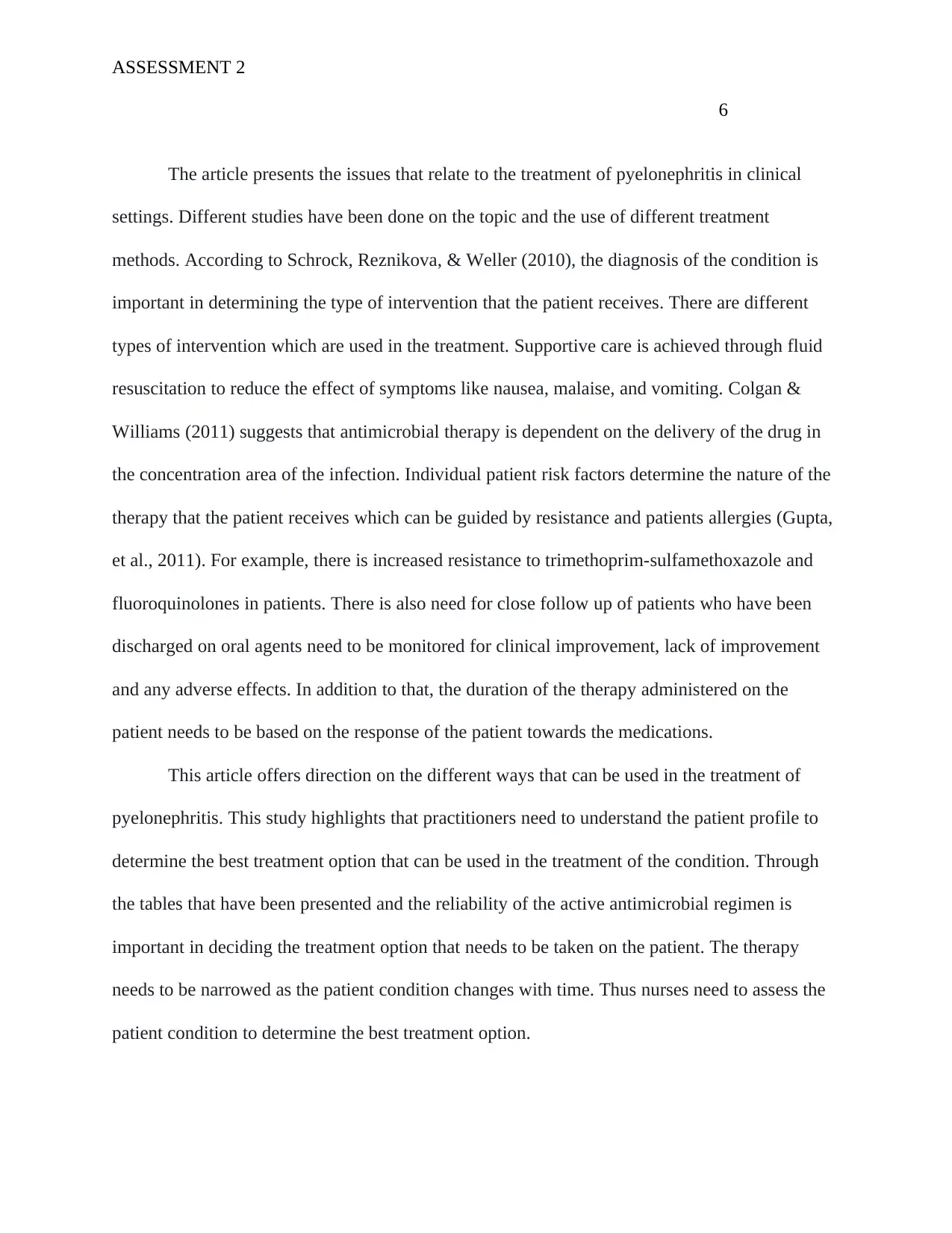
ASSESSMENT 2
6
The article presents the issues that relate to the treatment of pyelonephritis in clinical
settings. Different studies have been done on the topic and the use of different treatment
methods. According to Schrock, Reznikova, & Weller (2010), the diagnosis of the condition is
important in determining the type of intervention that the patient receives. There are different
types of intervention which are used in the treatment. Supportive care is achieved through fluid
resuscitation to reduce the effect of symptoms like nausea, malaise, and vomiting. Colgan &
Williams (2011) suggests that antimicrobial therapy is dependent on the delivery of the drug in
the concentration area of the infection. Individual patient risk factors determine the nature of the
therapy that the patient receives which can be guided by resistance and patients allergies (Gupta,
et al., 2011). For example, there is increased resistance to trimethoprim-sulfamethoxazole and
fluoroquinolones in patients. There is also need for close follow up of patients who have been
discharged on oral agents need to be monitored for clinical improvement, lack of improvement
and any adverse effects. In addition to that, the duration of the therapy administered on the
patient needs to be based on the response of the patient towards the medications.
This article offers direction on the different ways that can be used in the treatment of
pyelonephritis. This study highlights that practitioners need to understand the patient profile to
determine the best treatment option that can be used in the treatment of the condition. Through
the tables that have been presented and the reliability of the active antimicrobial regimen is
important in deciding the treatment option that needs to be taken on the patient. The therapy
needs to be narrowed as the patient condition changes with time. Thus nurses need to assess the
patient condition to determine the best treatment option.
6
The article presents the issues that relate to the treatment of pyelonephritis in clinical
settings. Different studies have been done on the topic and the use of different treatment
methods. According to Schrock, Reznikova, & Weller (2010), the diagnosis of the condition is
important in determining the type of intervention that the patient receives. There are different
types of intervention which are used in the treatment. Supportive care is achieved through fluid
resuscitation to reduce the effect of symptoms like nausea, malaise, and vomiting. Colgan &
Williams (2011) suggests that antimicrobial therapy is dependent on the delivery of the drug in
the concentration area of the infection. Individual patient risk factors determine the nature of the
therapy that the patient receives which can be guided by resistance and patients allergies (Gupta,
et al., 2011). For example, there is increased resistance to trimethoprim-sulfamethoxazole and
fluoroquinolones in patients. There is also need for close follow up of patients who have been
discharged on oral agents need to be monitored for clinical improvement, lack of improvement
and any adverse effects. In addition to that, the duration of the therapy administered on the
patient needs to be based on the response of the patient towards the medications.
This article offers direction on the different ways that can be used in the treatment of
pyelonephritis. This study highlights that practitioners need to understand the patient profile to
determine the best treatment option that can be used in the treatment of the condition. Through
the tables that have been presented and the reliability of the active antimicrobial regimen is
important in deciding the treatment option that needs to be taken on the patient. The therapy
needs to be narrowed as the patient condition changes with time. Thus nurses need to assess the
patient condition to determine the best treatment option.
⊘ This is a preview!⊘
Do you want full access?
Subscribe today to unlock all pages.

Trusted by 1+ million students worldwide
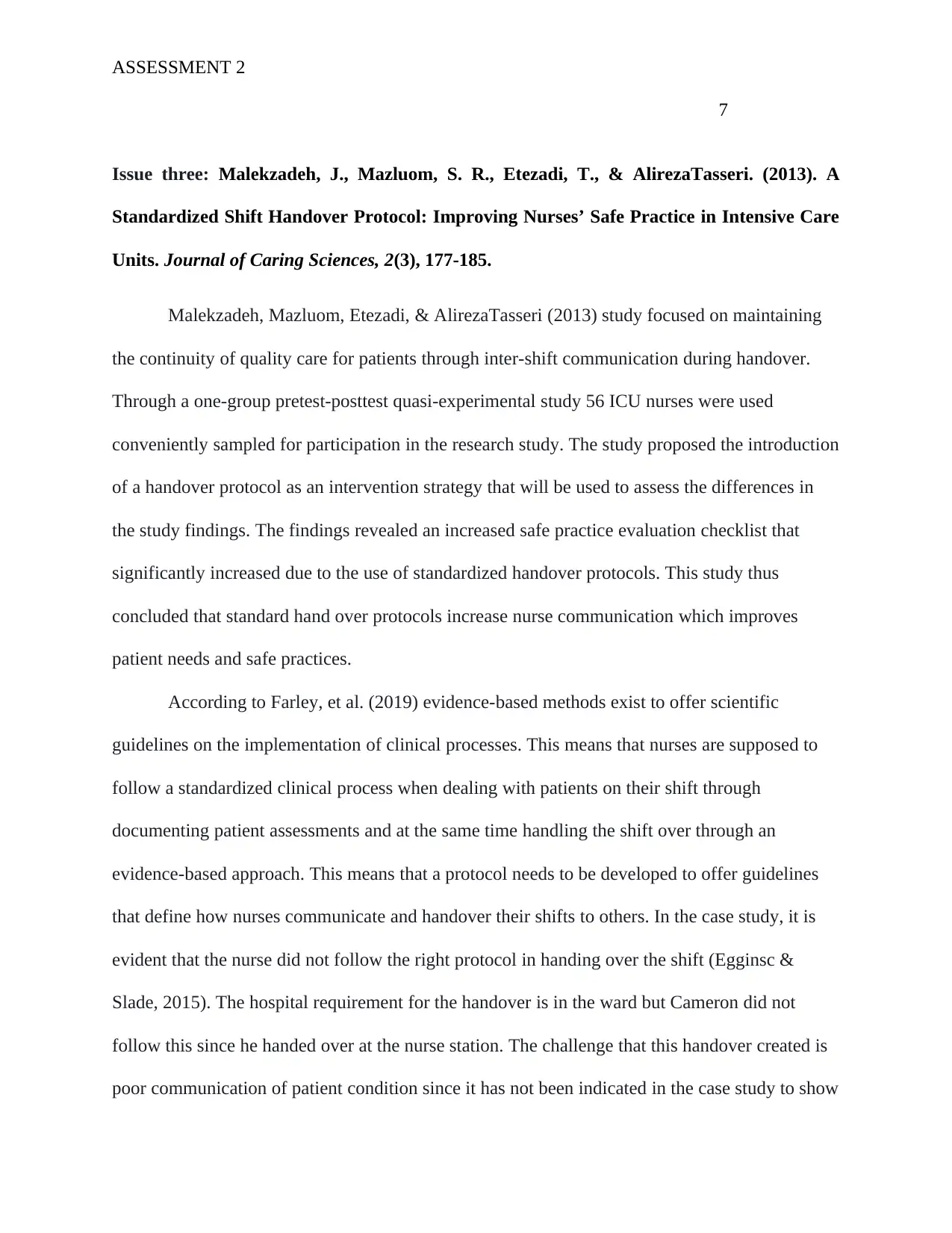
ASSESSMENT 2
7
Issue three: Malekzadeh, J., Mazluom, S. R., Etezadi, T., & AlirezaTasseri. (2013). A
Standardized Shift Handover Protocol: Improving Nurses’ Safe Practice in Intensive Care
Units. Journal of Caring Sciences, 2(3), 177-185.
Malekzadeh, Mazluom, Etezadi, & AlirezaTasseri (2013) study focused on maintaining
the continuity of quality care for patients through inter-shift communication during handover.
Through a one-group pretest-posttest quasi-experimental study 56 ICU nurses were used
conveniently sampled for participation in the research study. The study proposed the introduction
of a handover protocol as an intervention strategy that will be used to assess the differences in
the study findings. The findings revealed an increased safe practice evaluation checklist that
significantly increased due to the use of standardized handover protocols. This study thus
concluded that standard hand over protocols increase nurse communication which improves
patient needs and safe practices.
According to Farley, et al. (2019) evidence-based methods exist to offer scientific
guidelines on the implementation of clinical processes. This means that nurses are supposed to
follow a standardized clinical process when dealing with patients on their shift through
documenting patient assessments and at the same time handling the shift over through an
evidence-based approach. This means that a protocol needs to be developed to offer guidelines
that define how nurses communicate and handover their shifts to others. In the case study, it is
evident that the nurse did not follow the right protocol in handing over the shift (Egginsc &
Slade, 2015). The hospital requirement for the handover is in the ward but Cameron did not
follow this since he handed over at the nurse station. The challenge that this handover created is
poor communication of patient condition since it has not been indicated in the case study to show
7
Issue three: Malekzadeh, J., Mazluom, S. R., Etezadi, T., & AlirezaTasseri. (2013). A
Standardized Shift Handover Protocol: Improving Nurses’ Safe Practice in Intensive Care
Units. Journal of Caring Sciences, 2(3), 177-185.
Malekzadeh, Mazluom, Etezadi, & AlirezaTasseri (2013) study focused on maintaining
the continuity of quality care for patients through inter-shift communication during handover.
Through a one-group pretest-posttest quasi-experimental study 56 ICU nurses were used
conveniently sampled for participation in the research study. The study proposed the introduction
of a handover protocol as an intervention strategy that will be used to assess the differences in
the study findings. The findings revealed an increased safe practice evaluation checklist that
significantly increased due to the use of standardized handover protocols. This study thus
concluded that standard hand over protocols increase nurse communication which improves
patient needs and safe practices.
According to Farley, et al. (2019) evidence-based methods exist to offer scientific
guidelines on the implementation of clinical processes. This means that nurses are supposed to
follow a standardized clinical process when dealing with patients on their shift through
documenting patient assessments and at the same time handling the shift over through an
evidence-based approach. This means that a protocol needs to be developed to offer guidelines
that define how nurses communicate and handover their shifts to others. In the case study, it is
evident that the nurse did not follow the right protocol in handing over the shift (Egginsc &
Slade, 2015). The hospital requirement for the handover is in the ward but Cameron did not
follow this since he handed over at the nurse station. The challenge that this handover created is
poor communication of patient condition since it has not been indicated in the case study to show
Paraphrase This Document
Need a fresh take? Get an instant paraphrase of this document with our AI Paraphraser
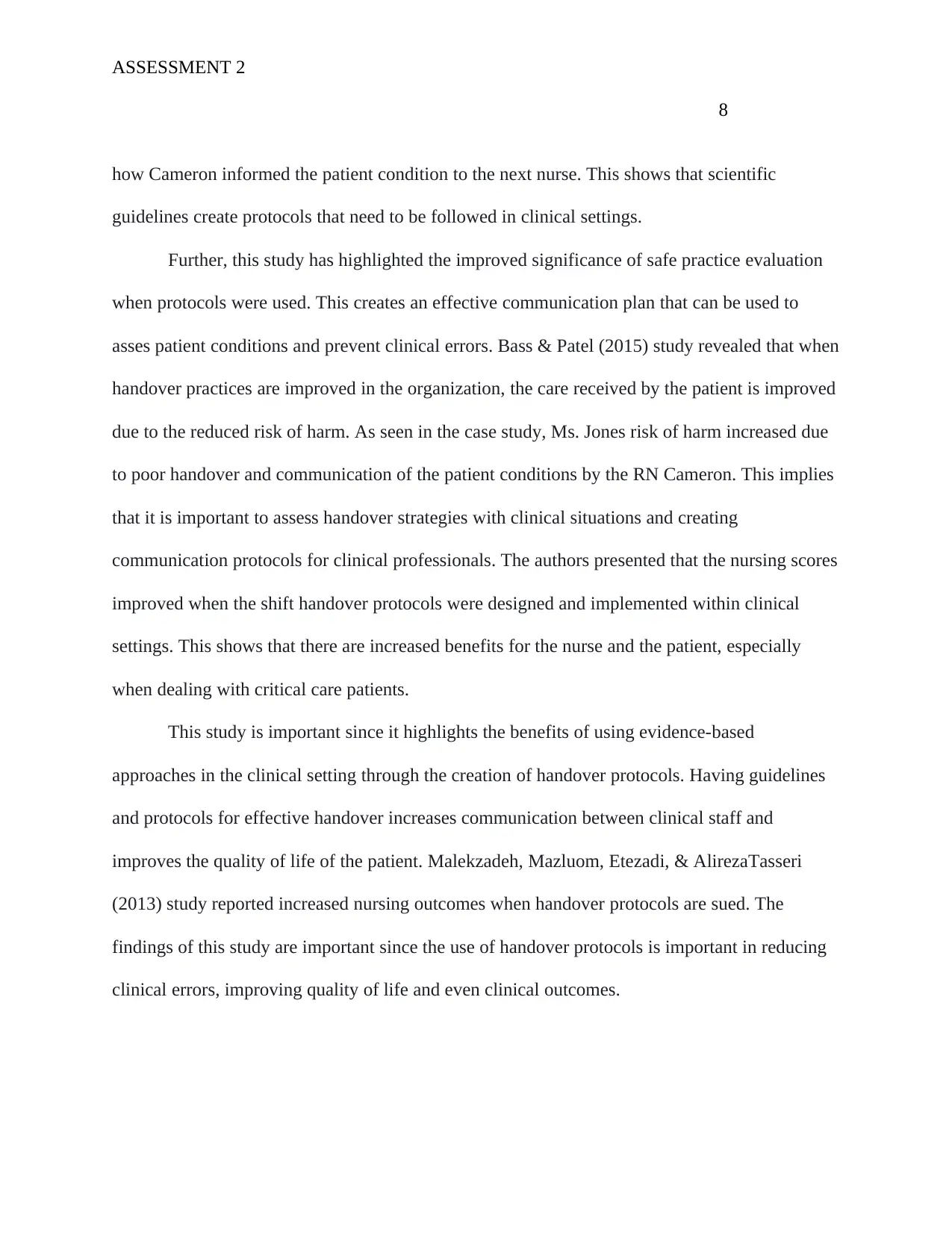
ASSESSMENT 2
8
how Cameron informed the patient condition to the next nurse. This shows that scientific
guidelines create protocols that need to be followed in clinical settings.
Further, this study has highlighted the improved significance of safe practice evaluation
when protocols were used. This creates an effective communication plan that can be used to
asses patient conditions and prevent clinical errors. Bass & Patel (2015) study revealed that when
handover practices are improved in the organization, the care received by the patient is improved
due to the reduced risk of harm. As seen in the case study, Ms. Jones risk of harm increased due
to poor handover and communication of the patient conditions by the RN Cameron. This implies
that it is important to assess handover strategies with clinical situations and creating
communication protocols for clinical professionals. The authors presented that the nursing scores
improved when the shift handover protocols were designed and implemented within clinical
settings. This shows that there are increased benefits for the nurse and the patient, especially
when dealing with critical care patients.
This study is important since it highlights the benefits of using evidence-based
approaches in the clinical setting through the creation of handover protocols. Having guidelines
and protocols for effective handover increases communication between clinical staff and
improves the quality of life of the patient. Malekzadeh, Mazluom, Etezadi, & AlirezaTasseri
(2013) study reported increased nursing outcomes when handover protocols are sued. The
findings of this study are important since the use of handover protocols is important in reducing
clinical errors, improving quality of life and even clinical outcomes.
8
how Cameron informed the patient condition to the next nurse. This shows that scientific
guidelines create protocols that need to be followed in clinical settings.
Further, this study has highlighted the improved significance of safe practice evaluation
when protocols were used. This creates an effective communication plan that can be used to
asses patient conditions and prevent clinical errors. Bass & Patel (2015) study revealed that when
handover practices are improved in the organization, the care received by the patient is improved
due to the reduced risk of harm. As seen in the case study, Ms. Jones risk of harm increased due
to poor handover and communication of the patient conditions by the RN Cameron. This implies
that it is important to assess handover strategies with clinical situations and creating
communication protocols for clinical professionals. The authors presented that the nursing scores
improved when the shift handover protocols were designed and implemented within clinical
settings. This shows that there are increased benefits for the nurse and the patient, especially
when dealing with critical care patients.
This study is important since it highlights the benefits of using evidence-based
approaches in the clinical setting through the creation of handover protocols. Having guidelines
and protocols for effective handover increases communication between clinical staff and
improves the quality of life of the patient. Malekzadeh, Mazluom, Etezadi, & AlirezaTasseri
(2013) study reported increased nursing outcomes when handover protocols are sued. The
findings of this study are important since the use of handover protocols is important in reducing
clinical errors, improving quality of life and even clinical outcomes.
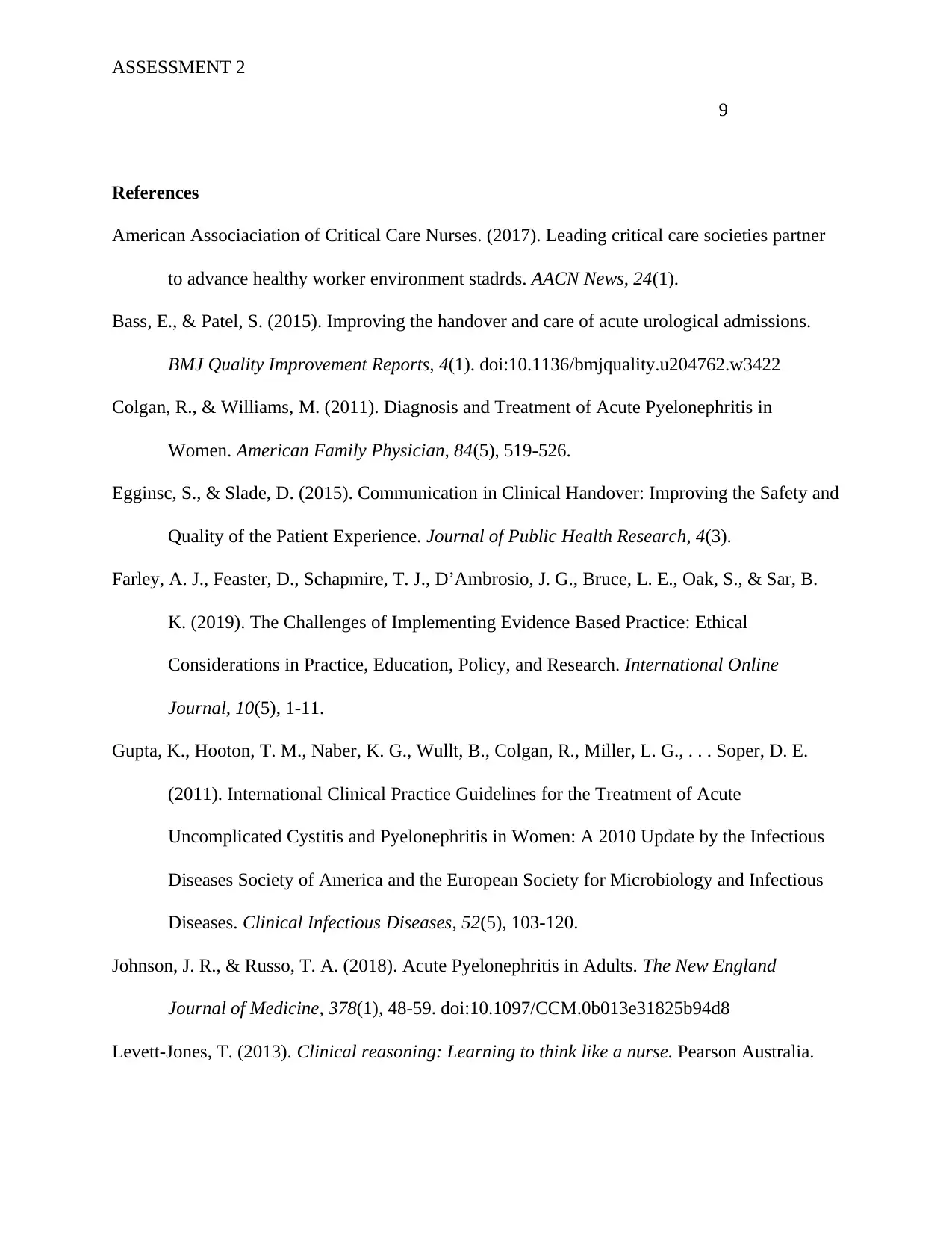
ASSESSMENT 2
9
References
American Associaciation of Critical Care Nurses. (2017). Leading critical care societies partner
to advance healthy worker environment stadrds. AACN News, 24(1).
Bass, E., & Patel, S. (2015). Improving the handover and care of acute urological admissions.
BMJ Quality Improvement Reports, 4(1). doi:10.1136/bmjquality.u204762.w3422
Colgan, R., & Williams, M. (2011). Diagnosis and Treatment of Acute Pyelonephritis in
Women. American Family Physician, 84(5), 519-526.
Egginsc, S., & Slade, D. (2015). Communication in Clinical Handover: Improving the Safety and
Quality of the Patient Experience. Journal of Public Health Research, 4(3).
Farley, A. J., Feaster, D., Schapmire, T. J., D’Ambrosio, J. G., Bruce, L. E., Oak, S., & Sar, B.
K. (2019). The Challenges of Implementing Evidence Based Practice: Ethical
Considerations in Practice, Education, Policy, and Research. International Online
Journal, 10(5), 1-11.
Gupta, K., Hooton, T. M., Naber, K. G., Wullt, B., Colgan, R., Miller, L. G., . . . Soper, D. E.
(2011). International Clinical Practice Guidelines for the Treatment of Acute
Uncomplicated Cystitis and Pyelonephritis in Women: A 2010 Update by the Infectious
Diseases Society of America and the European Society for Microbiology and Infectious
Diseases. Clinical Infectious Diseases, 52(5), 103-120.
Johnson, J. R., & Russo, T. A. (2018). Acute Pyelonephritis in Adults. The New England
Journal of Medicine, 378(1), 48-59. doi:10.1097/CCM.0b013e31825b94d8
Levett-Jones, T. (2013). Clinical reasoning: Learning to think like a nurse. Pearson Australia.
9
References
American Associaciation of Critical Care Nurses. (2017). Leading critical care societies partner
to advance healthy worker environment stadrds. AACN News, 24(1).
Bass, E., & Patel, S. (2015). Improving the handover and care of acute urological admissions.
BMJ Quality Improvement Reports, 4(1). doi:10.1136/bmjquality.u204762.w3422
Colgan, R., & Williams, M. (2011). Diagnosis and Treatment of Acute Pyelonephritis in
Women. American Family Physician, 84(5), 519-526.
Egginsc, S., & Slade, D. (2015). Communication in Clinical Handover: Improving the Safety and
Quality of the Patient Experience. Journal of Public Health Research, 4(3).
Farley, A. J., Feaster, D., Schapmire, T. J., D’Ambrosio, J. G., Bruce, L. E., Oak, S., & Sar, B.
K. (2019). The Challenges of Implementing Evidence Based Practice: Ethical
Considerations in Practice, Education, Policy, and Research. International Online
Journal, 10(5), 1-11.
Gupta, K., Hooton, T. M., Naber, K. G., Wullt, B., Colgan, R., Miller, L. G., . . . Soper, D. E.
(2011). International Clinical Practice Guidelines for the Treatment of Acute
Uncomplicated Cystitis and Pyelonephritis in Women: A 2010 Update by the Infectious
Diseases Society of America and the European Society for Microbiology and Infectious
Diseases. Clinical Infectious Diseases, 52(5), 103-120.
Johnson, J. R., & Russo, T. A. (2018). Acute Pyelonephritis in Adults. The New England
Journal of Medicine, 378(1), 48-59. doi:10.1097/CCM.0b013e31825b94d8
Levett-Jones, T. (2013). Clinical reasoning: Learning to think like a nurse. Pearson Australia.
⊘ This is a preview!⊘
Do you want full access?
Subscribe today to unlock all pages.

Trusted by 1+ million students worldwide
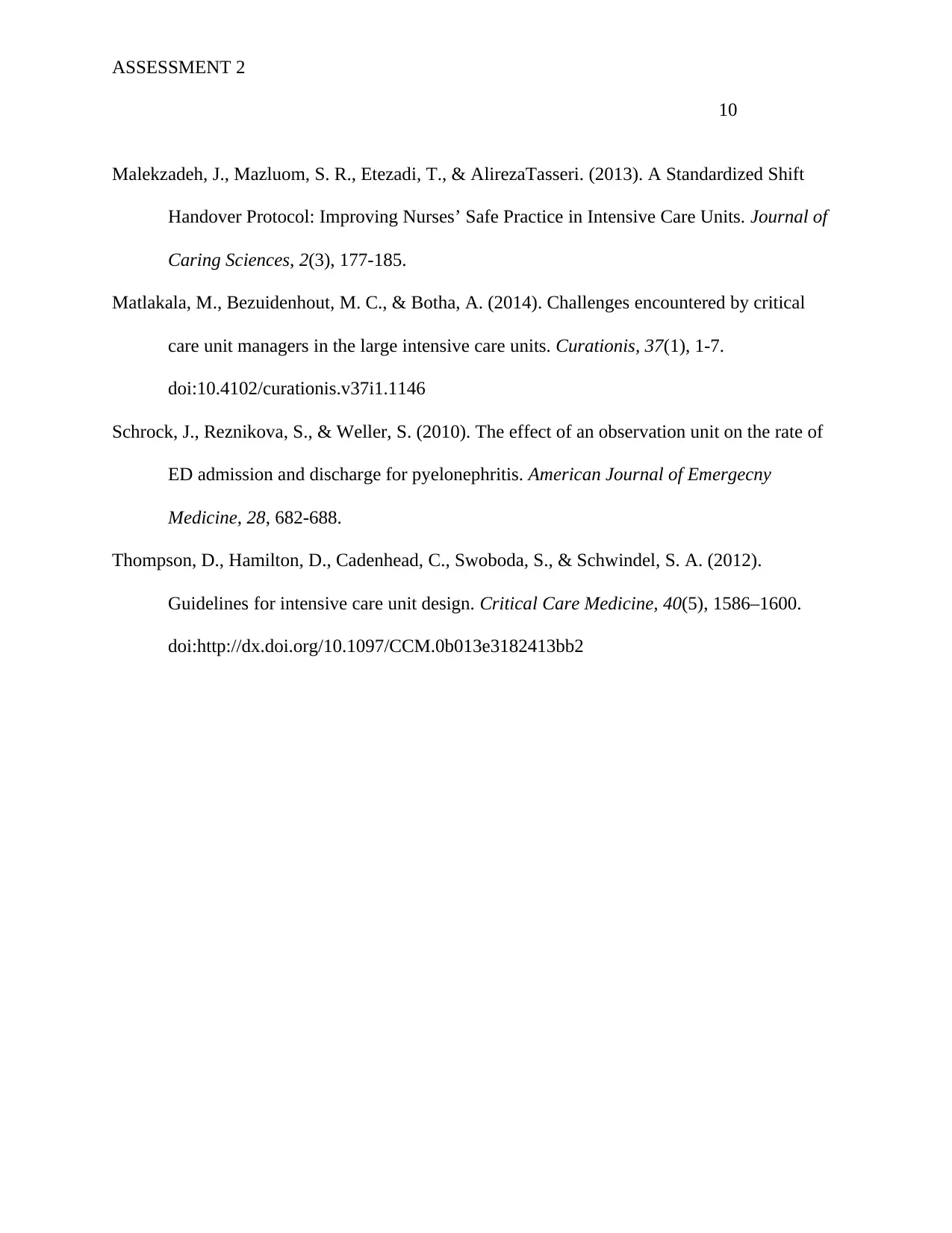
ASSESSMENT 2
10
Malekzadeh, J., Mazluom, S. R., Etezadi, T., & AlirezaTasseri. (2013). A Standardized Shift
Handover Protocol: Improving Nurses’ Safe Practice in Intensive Care Units. Journal of
Caring Sciences, 2(3), 177-185.
Matlakala, M., Bezuidenhout, M. C., & Botha, A. (2014). Challenges encountered by critical
care unit managers in the large intensive care units. Curationis, 37(1), 1-7.
doi:10.4102/curationis.v37i1.1146
Schrock, J., Reznikova, S., & Weller, S. (2010). The effect of an observation unit on the rate of
ED admission and discharge for pyelonephritis. American Journal of Emergecny
Medicine, 28, 682-688.
Thompson, D., Hamilton, D., Cadenhead, C., Swoboda, S., & Schwindel, S. A. (2012).
Guidelines for intensive care unit design. Critical Care Medicine, 40(5), 1586–1600.
doi:http://dx.doi.org/10.1097/CCM.0b013e3182413bb2
10
Malekzadeh, J., Mazluom, S. R., Etezadi, T., & AlirezaTasseri. (2013). A Standardized Shift
Handover Protocol: Improving Nurses’ Safe Practice in Intensive Care Units. Journal of
Caring Sciences, 2(3), 177-185.
Matlakala, M., Bezuidenhout, M. C., & Botha, A. (2014). Challenges encountered by critical
care unit managers in the large intensive care units. Curationis, 37(1), 1-7.
doi:10.4102/curationis.v37i1.1146
Schrock, J., Reznikova, S., & Weller, S. (2010). The effect of an observation unit on the rate of
ED admission and discharge for pyelonephritis. American Journal of Emergecny
Medicine, 28, 682-688.
Thompson, D., Hamilton, D., Cadenhead, C., Swoboda, S., & Schwindel, S. A. (2012).
Guidelines for intensive care unit design. Critical Care Medicine, 40(5), 1586–1600.
doi:http://dx.doi.org/10.1097/CCM.0b013e3182413bb2
1 out of 10
Related Documents
Your All-in-One AI-Powered Toolkit for Academic Success.
+13062052269
info@desklib.com
Available 24*7 on WhatsApp / Email
![[object Object]](/_next/static/media/star-bottom.7253800d.svg)
Unlock your academic potential
Copyright © 2020–2025 A2Z Services. All Rights Reserved. Developed and managed by ZUCOL.





